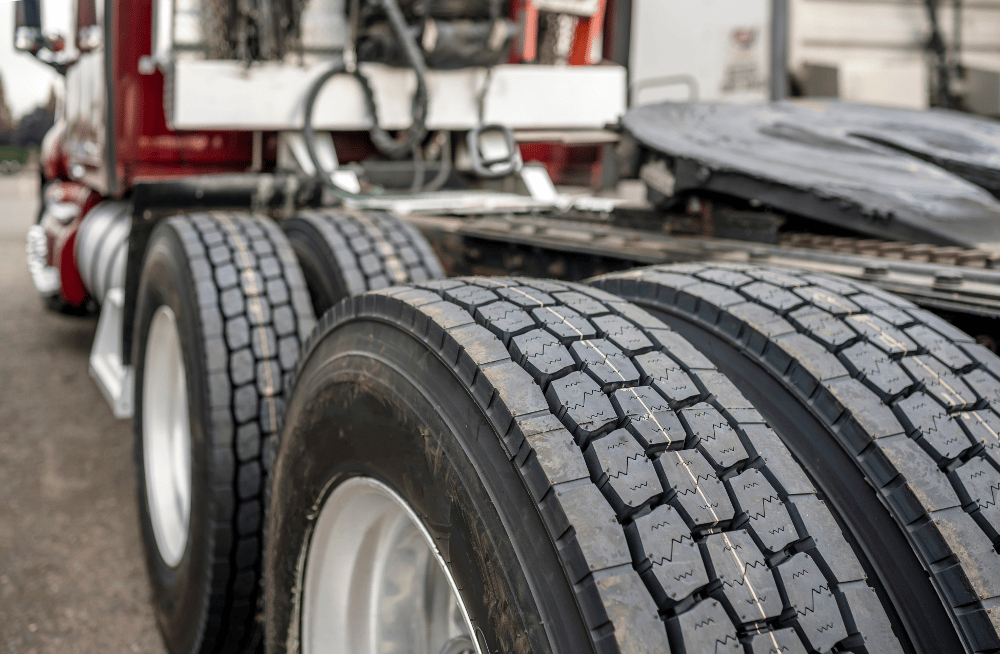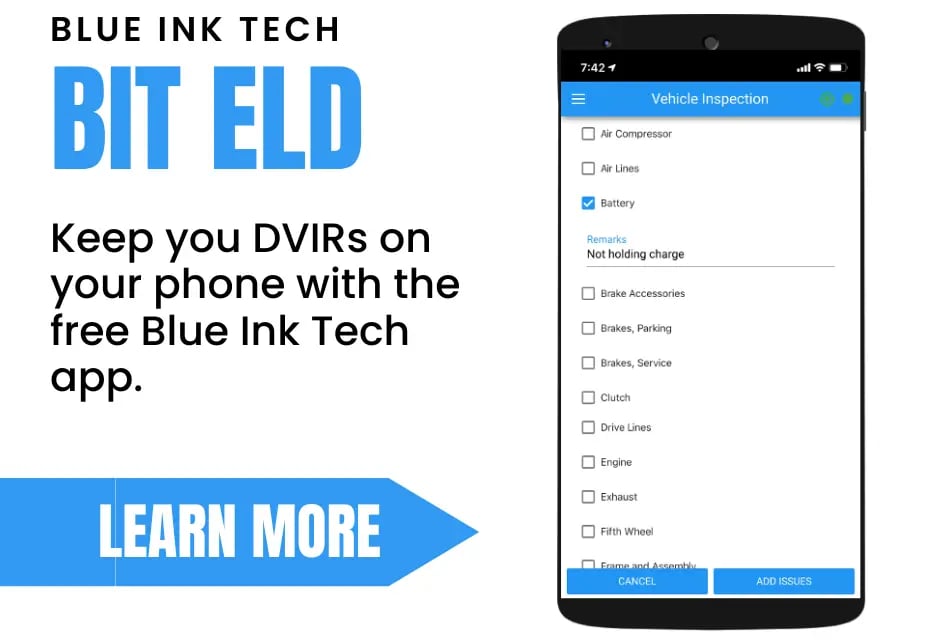
If you drive an semi truck, you know how important it is to maintain and replace your tires regularly. Driving with damaged or worn-out tires can lead to accidents, costly repairs, fines and delays in your delivery schedule.
In this blog post, we'll provide a comprehensive guide on how to change a tire on an semi, discussing the required tread depth, tire issues, and leaks to look for during a pre-trip inspection.
We'll also compare the pros and cons of brand new tires vs. recapped tires and discuss proper inflation methods, and why maintaining adequate tire pressure is crucial for your truck and trailer.
Required Tread Depth, Tire Issues, and Tire Leaks
Pre-trip inspections of DVIR's are a crucial part of any truck driver's routine, as they help identify potential issues before you hit the road. Tires should be thoroughly inspected for tread depth, damage, and leaks.
Tire violations fall under vehicle maintenance issues as part of the 7 FMCSA BASICs and can drivers can get placed out-of-service until the issues are fixed. Tire related violations carry a large severity weight and can drastically impact a carriers CSA score. It is important that checking tires be a top priority from drivers during their pre-trip inspections because this is one of the easiest violations for a DOT officer to find during a level 1 inspection.
Let's discuss some of these factors in detail:
Tread Depth
The tread depth of your tires is a critical aspect of ensuring their safety and performance. According to the Federal Motor Carrier Safety Administration (FMCSA), the minimum required tread depth for steer tires is 4/32-inch, while other tires on a commercial vehicle should have a tread depth of at least 2/32-inch. To measure the tread depth, you can use a tread depth gauge or a simple penny test. If the tread is too worn, it's time to replace the tire.
Tire Issues
During your pre-trip inspection, look for common tire issues such as sidewall damage, irregular wear, exposed cords, cuts, punctures, or bulges. These issues can be signs that a tire is approaching the end of its life or has experienced damage, increasing the risk of a blowout or failure on the road. If you discover any of these issues, replace the affected tire as soon as possible.
Tire Leaks
Slow leaks can be difficult to detect but can cause a significant loss of tire pressure over time, resulting in poor fuel efficiency, uneven tire wear, and even a blowout. Inspect your tires for any signs of leakage, paying close attention to the valve stem and the area where the tire meets the rim. If you suspect a leak, have it professionally inspected and repaired.
Changing a Tire on a Semi Truck or Trailer
If you find that your tires tread depth is off, the tire has leaks or other damage then it is time to change the tire. Changing a tire on a semi truck or trailer is a challenging task, but with the right tools and knowledge, it's manageable. Here are the steps to follow:
Gather the Necessary Tools
To change a tire on a semi, you'll need a heavy-duty hydraulic jack, a torque wrench, wheel chocks, safety gear (gloves, safety glasses, and reflective vest), a tire pressure gauge, and a new or recapped tire.
Park the Truck on a Flat Surface
Find a level, solid surface to park your truck and engage the parking brake. Place wheel chocks on both sides of the wheels on the opposite end of the truck to prevent any movement while working.
Loosen the Lug Nuts
Put on your safety gear and use a torque wrench to loosen the lug nuts on the wheel you're replacing, turning them counterclockwise. Do not fully remove the lug nuts yet.
Raise the Trailer with the Hydraulic Jack
Position the hydraulic jack under the trailer's frame, near the tire you're changing, and pump the jack until the tire is lifted off the ground.
Remove the Lug Nuts and the Flat Tire
With the tire lifted off the ground, completely remove the lug nuts and set them aside in a safe place. Carefully remove the flat or damaged tire from the axle, keeping in mind that these tires can weigh over 100 pounds.
Removing the Tire from the Rim
Using a tire hammer break the tire bead loose from the rim. If the tire is laying on the ground you might be able to do this by standing on the tire near the rim. If standing does not work then the hammer will do the trick.
Using 2 crow bars pry the tire using the rim as leverage and pull the tire over the rim. The second crowbar will pull more of the tire over the rim while the first crowbar keeps the tire from snapping back into rim.
If the tire bead is having a hard time coming over the rim try using grease to lube the tire bead and allowing it to slide over the rim easier.
Placing the New Tire on the Rim
Once the old tire is off use the same process to put the new tire on the rim. Using grease will allow the new tire slide over the rim easier. Use the crow bars to get the tire completely on the rim.
When the new tire is on the rim the hardest part will be getting the beads to seal against the tire. Making sure you have greased the entire bead will make getting a seal on the rim easier.
Install the New or Recapped Tire
Carefully position the new or recapped tire onto the axle, aligning the lug nut holes. Thread the lug nuts onto the studs by hand to prevent cross-threading, then tighten them with the torque wrench in a star pattern to ensure even pressure. Be sure not to fully tighten them yet.
Lower the Trailer and Finish Tightening the Lug Nuts
Slowly lower the hydraulic jack, allowing the trailer to rest on the newly installed tire. Once the weight is on the tire, use the torque wrench to fully tighten the lug nuts in a star pattern, ensuring they meet the manufacturer's torque specifications.
Check Tire Pressure
Use a tire pressure gauge to check the pressure of the newly installed tire and inflate it to the manufacturer's recommended level. Remember to also check the pressure of the other tires on your truck and trailer.
New Tires vs. Recapped Tires
When it's time to replace your truck's tires, you'll have to decide between new tires and recapped tires. There are many difference between these two types and really comes down to your preference and the amount of risk you are willing to take. Let's discuss the pros and cons of each option:
New Tires
Pros:
- Longer lifespan: New tires typically offer a longer lifespan than recapped tires due to their fresh rubber and full tread depth.
- Better performance: New tires usually provide better traction, handling, and braking performance.
- Manufacturer warranty: Most new tires come with a warranty from the manufacturer, providing some financial protection in case of defects.
Cons:
- Higher cost: New tires can be significantly more expensive than recapped tires.
Recapped Tires
Pros:
- Lower cost: Recapped tires are often cheaper than new tires, making them an appealing option for budget-conscious drivers.
- Environmentally friendly: Recapping tires extends their useful life and reduces waste, contributing to a greener and more sustainable industry.
Cons:
- Shorter lifespan: Recapped tires typically have a shorter lifespan than new tires due to their pre-worn casing.
- No manufacturer warranty: Recapped tires usually don't come with a warranty, so any issues or defects may result in additional out-of-pocket costs.
Proper Inflation and the Importance of Maintaining Adequate Tire Pressure
Maintaining proper tire pressure is critical for the safety and efficiency of your semi truck and trailer. Here's why it's important and what you can expect if you don't maintain adequate tire pressure:
Benefits of Proper Inflation
- Improved fuel efficiency: Properly inflated tires have less rolling resistance, which leads to better fuel economy.
- Even wear: Correct tire pressure ensures even wear across the tire's surface, resulting in a longer lifespan.
- Enhanced safety: Adequate tire pressure helps maintain optimal traction and handling, reducing the risk of blowouts and accidents.
Risks of Improper Inflation
- Underinflation: Underinflated tires generate more heat, increasing the risk of a blowout, and cause uneven wear, which can shorten their lifespan. Additionally, underinflated tires negatively impact fuel efficiency.
- Overinflation: Overinflated tires are more susceptible to damage from road hazards, have reduced traction, and are more likely to suffer from uneven wear.
By making sure that tire maintenance is a part of your drivers pre-trip inspection and your maintenance team's preventative maintenance program you can get the most out of every tire that you buy.

